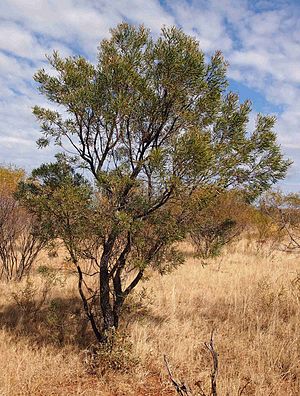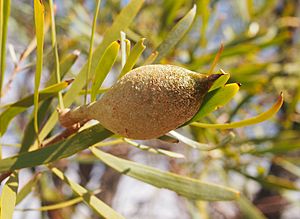Common hakea facts for kids
Quick facts for kids Common Hakea |
|
|---|---|
 |
|
 |
|
| Scientific classification | |
| Genus: |
Hakea
|
| Species: |
arborescens
|
 |
|
| Occurrence data from Australasian Virtual Herbarium | |
Hakea arborescens, also known as the common hakea or the yellow hakea, is a type of shrub or tree. It belongs to the Hakea family and grows naturally in parts of northern Australia.
What Does the Common Hakea Look Like?
This tall shrub or tree usually grows between 2 to 8 metres (6.6 to 26.2 ft) high. Its bark is rough and grey on the trunk and bigger branches. The leaves stay green all year. They are long and narrow, about 5 to 18 centimetres (2 to 7 in) long and 3 to 11 millimetres (0.118 to 0.433 in) wide.
The common hakea blooms from January to July. It produces pretty yellow-cream flowers. These flowers grow in clusters that are about 30 to 50 mm (1.2 to 2.0 in) long.
After the flowers, thick, woody fruits grow. They are shaped like an oval, about 28 to 58 mm (1.1 to 2.3 in) long and 14 to 26 mm (0.6 to 1.0 in) wide. Inside each fruit, there are two black seeds. These seeds are about 10 to 15 mm (0.39 to 0.59 in) long and have a thin yellow wing.
How Did It Get Its Name?
The Hakea arborescens was first officially described in 1810 by a botanist named Robert Brown. He wrote about it in a scientific paper.
The second part of its scientific name, arborescens, comes from Latin. It means "becoming tree-like." This name describes how the plant can grow into a tree.
Where Does the Common Hakea Grow?
The common hakea is found only in certain areas of Australia. These include the Top End of the Northern Territory, the Kimberley region in Western Australia, and northern Queensland.
You can often find it growing near the coast on sand dunes. It also grows inland in soils that are a bit salty, along creek banks, or in low-lying wet areas like swamps. This plant likes to grow on sandstone, quartzite, and limestone. It is usually part of monsoon forests or Eucalyptus woodlands.

